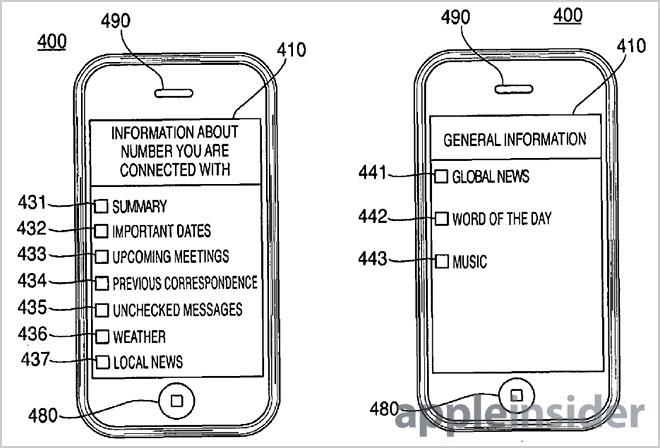A patent granted to Apple by the U.S. Patent and Trademark Office on Tuesday describes an automated system in which an on-hold caller is shown adaptive information, like events in a user's calendar, based on contextual data taken from the phone call.
Apple's U.S. Patent No. 8,412,164 for a "Communications system that provides user-selectable data when user is on-hold," reveals a system that provides for user-selectable data, or "adaptive information," to be displayed when a user is on hold during a phone call.
The so-called "adaptive information" covers a number of possibilities, but is defined as data that "can be automatically presented at times when the user may otherwise not expect to be presented with information." Unlike "static information," which includes the length of a call or caller ID, the adaptive information is generated every time a new connection is made between two callers. By customizing the generated content based on who is on the line, date, time, user's schedule, location, and other metrics, the system can display news, weather, music or other information that "may not necessarily be stored on a user's device." Thus, information gathered and presented can be pulled from an off-site server if needed.
A user must first create a profile for the call waiting system. Here, a number of adaptive information assets can be chosen which, when it is determined that a user is on hold or when a user specifies they are on hold, can present the appropriate data.
From the patent's description:
Adaptive information can also be presented using graphical representations. Graphical representations of adaptive information can be used separately from or in combination with audio signals. For example, a device can display a picture of the person a user is communicating with while also providing important facts about that person through an audio signal.
When a user is no longer on hold, the audio can be turned down or "muted" altogether. The graphical information can be displayed as a semi-transparent overlay that sits atop static call data.
Illustration of user interface of described features.Many of the examples listed have the intention of providing the user with information relevant to the upcoming conversation. Perhaps most intriguing is the ability for the system to present information gleaned from contextual clues taken from the conversation. The system can monitor a call and pick out contextual data like a certain keyword that was distinguished during the course of a conversation, as well as how many times the keyword was used, to offer deemed useful data to the user while on hold.
In one embodiment, the on-hold information can be based on a characteristic of the call, such as the identity of the person on the line. In this scenario, adaptive information presented can include the names of a person's family, birthday, hobbies or other facts of interest. Going deeper, gathered data can also be displayed, like the last time the user communicated with the person, or how many unsuccessful communication attempts were made.
Another example discusses adaptive information based on a user's schedule. For example, upcoming meetings, birthdays or appointments relating to the person a user is communicating with can be presented while on hold.
Location can also be factored into the system. For example, a user can be presented with weather information for their current position. In another example, the user may be shown the information pertaining to the other end of the connection, or even the proximity between the two nodes.
Time of the day is also taken into consideration, with early morning calls eliciting a user's schedule for the day, while late night calls can present news or weather forecasts.
One interesting aspect of the invention notes that advertisements can be presented to a user when they are on hold, with the ad space sold to offset some of the costs associated with the call.
Examples of adaptive information.It is unclear if Apple intends to implement any of the inventions described above, but such a system could be viable given the sheer number of iPhones in use around the world.
The patent was first filed for in 2011 as a continuation of a property applied for in 2007, and credits Michael M. Lee as its inventor.
 Mikey Campbell
Mikey Campbell




-xl-m.jpg)


-m.jpg)






 Chip Loder
Chip Loder
 Thomas Sibilly
Thomas Sibilly
 Wesley Hilliard
Wesley Hilliard
 Christine McKee
Christine McKee
 Amber Neely
Amber Neely
 William Gallagher
William Gallagher
 Malcolm Owen
Malcolm Owen









4 Comments
Very nice... This information screen could also be explicitly brought up and dismissed when the user is on speaker. Perhaps via the contact button...
It is a very novel concept especially the advertisement section. What if this feature was turned on, on the new "cheaper" iPhone Apple is working on. It makes sense. You get people into the Apple ecosystem. It is a loss leader for them. They could still make money from the end user of these "cheaper" iPhones from not only the advertising but also the downloads of music and apps. There is also the halo effect to consider as well. Apple wouldn't sacrifice anything they deemed as substandard. It would probably be some sort of hardware addition to the "cheaper" iPhones that couldn't be easily altered. It's simple: what an iPhone but can't afford it, we'll give you one with advertisements on it.
What I want is 'visual phone trees' so that I can see all the options on one screen and click on where I want to go instead of the blind linear maze I'm subjected to now.
Well unnesary stuff but still improved and doable.